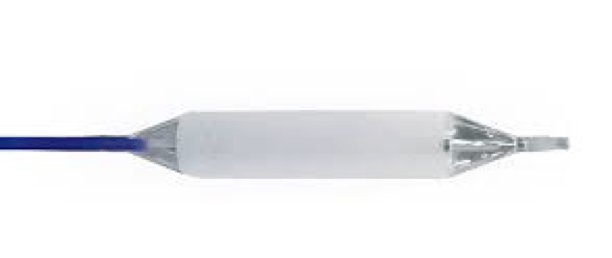Dilatation of a urethral stenosis by the Optilume dilatation balloon
This innovative treatment combines proprietary balloon dilatation and drug delivery technology to reduce recurrence of urethral stricture. This is a new treatment alternative for recurrent urethral stenosis following conventional treatment failure. The balloon seems to be a good compromise; in fact, this treatment offers better success rates than conventional balloon dilatation and is less invasive than urethroplasty, which is the plastic-surgical reconstruction of the urethra.


What is a urethral dilatation by Optilume?
It is an innovative and minimally invasive treatment for urethral stenosis. The balloon is covered with antiproliferative scar tissue. Optilume works by inhibiting the growth of new scar tissue that often occurs after dilatations. It is an effective alternative to traditional endoscopic treatments, offering immediate and minimally invasive relief.
Patient follow-up results show that after one year, 3 out of 4 patients who received Optilume treatment had no stenosis. These men, who had failed previous endoscopic treatments, had a 290% improvement in urinary output, an 80% reduction in symptoms, and no serious complications.
Patient follow-up results show that after one year, 3 out of 4 patients who received Optilume treatment had no stenosis. These men, who had failed previous endoscopic treatments, had a 290% improvement in urinary output, an 80% reduction in symptoms, and no serious complications.
What is Paclitaxel?
Paclitaxel, the drug that covers the balloon, is an antiproliferative drug used effectively in millions of patients worldwide since 1992, in various applications. The narrowing of the urethra is secondary to fibrosis formation, caused by excessive synthesis of collagen. This results in a soft tissue and a decrease in the size of the urethral light. Some antifibrotic drugs have been used to limit the formation of urethral strictures, such as Paclitaxel. The rapid absorption of the highly lipophilic drug, Paclitaxel, limits overactive cell proliferation and the generation of fibrotic scar tissue, which leads to recurrent narrowing.
It has a potential for long-term relief.
It has a potential for long-term relief.
How does Optilume urethral dilatation work?
The Optilume procedure is similar to the traditional mechanical expansion method, making it easy to perform. The dynamic balloon expands in the tissues, creating microcracks facilitating the circumferential absorption of the drug. The balloon inflates to create microcracks in the tissue, opening the way for drug absorption. The hydrophilic coating facilitates the rapid release of Paclitaxel. The hydrophobic and lipophilic properties promote rapid cellular uptake, allowing the drug to cross the urethral wall and reside in tissues.
By combining simple and effective balloon dilatation with localized delivery of a proven antiproliferative, Optilume aims to provide long-term relief from stenosis recurrence.
By combining simple and effective balloon dilatation with localized delivery of a proven antiproliferative, Optilume aims to provide long-term relief from stenosis recurrence.
How does Optilume Urethral Dilatation Work?
It is performed under mild sedation and local anesthesia, in a lying position (on the back) and legs in stirrups.
Sterile fields are set up and a flexible cystoscope is introduced inside the urethra to visualize the stenosis.
A hypophyllic guide is introduced and a part is wrapped in the bladder. The dilatation balloon is slid on the guide and is placed properly under direct vision. The balloon is then inflated to 10 atmospheres and is kept inflated for 5 minutes. The balloon is then removed. Lastly, a urinary catheter is introduced in the bladder and a drainage bag is attached to the thigh.
Sterile fields are set up and a flexible cystoscope is introduced inside the urethra to visualize the stenosis.
A hypophyllic guide is introduced and a part is wrapped in the bladder. The dilatation balloon is slid on the guide and is placed properly under direct vision. The balloon is then inflated to 10 atmospheres and is kept inflated for 5 minutes. The balloon is then removed. Lastly, a urinary catheter is introduced in the bladder and a drainage bag is attached to the thigh.
What are the benefits of Optilume urethral dilatation?
- Lower risk of recurring urethral stenosis.
- Minimally invasive.
- Compatible with flexible cystoscope for maximum patient comfort.
- Dynamic balloon compliance provides optimal expansion for urology applications.
- Tapered tip of the tip is non-traumatic and moves easily over the guide wire.
What are the possible complications of Optilume urethral dilatation?
Complications directly related to Optilume dilatation are rare, but possible:
- Urinary tract infection is the most common complication.
- Bleeding by the urethra called urethrorrhagia. Should it be prolonged or if it is associated with pelvic pain or difficulty in evacuating urine due to clots, contact Dr. Marois’ nurses.
- Hematoma and "swelling" of the genitals can occur (rare).
- Improving urinary disorders can take several weeks to appear.
References
Jessica M. DeLong, Michael J. Ehlert, Bradley A. Erickson, Kaiser J. Robertson,
Ramón Virasoro, Sean P. Elliott. One-Year Outcomes of the ROBUST II Study: Evaluating the Use of a Drug-Coated Balloon for Treatment of Urethral Stricture. SIUJ • Volume 3, Number 1 • January 2022.
Sean P. Elliott, Karl Coutinho, Kaiser J. Robertson et al. One-Year Results for the ROBUST III Randomized Controlled Trial Evaluating the Optilume Drug-Coated Balloon for Anterior Urethral Strictures. Journal of Urology, Vol. 207, 1, April 2022.
Sean P. Elliott, Karl Coutinho, Kaiser J. Robertson et al. One-Year Results for the ROBUST III Randomized Controlled Trial Evaluating the Optilume Drug-Coated Balloon for Anterior Urethral Strictures. Journal of Urology, Vol. 207, 1, April 2022.


